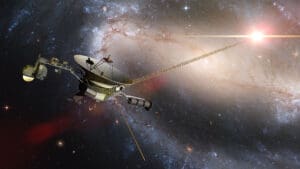

In this edition of Tech Time Warp, we take a look at how, for almost 47 years, NASA’s Voyager 1 spacecraft has transmitted the amazing secrets of the universe back to Earth. Along with that, the news that engineers had found a way to work around a damaged memory chip from MORE THAN 15 BILLION MILES away should give you hope the next time you’re on hold with tech support. (After five months of nonsense transmissions, engineers began receiving usable data from Voyager again April 20, two days after deploying a delicate data transfer that involved splitting corrupted code and moving it to available pockets of free memory, which isn’t plentiful—this is a 47-year-old system, after all.)
Exploring the cosmos
This technological masterstroke is just the latest chapter in the storied history of the Voyager 1 and 2 missions, which began in 1965 when NASA scientists calculated it was possible for a spacecraft launched in the late 1970s to visit the four outer giant planets, with the gravitational pull of each planet swinging Voyager on to the next. This particular planetary alignment occurs only once every 176 years! Voyager 2 launched Aug. 20, 1977, and Voyager 1 Sept. 6 of that year. (Voyager 2 reached Jupiter and Saturn after Voyager 1, hence the “2.”)
Voyager mission highlights include the discovery of the first active volcanoes outside Earth; the first images of Jupiter’s ring system; the discovery of three of Saturn’s moons: Atlas, Prometheus and Pandora; and the first up-close visits to Uranus and Neptune. On Valentine’s Day 1990, Voyager 1 took its last images—the “Solar System Family Portrait”—before scientists turned its cameras off to conserve energy. Voyager 1 became the first human-made object in interstellar space on Aug. 25, 2012.
Did you enjoy this installation of SmarterMSP’s Tech Time Warp? Check out others here.
Photo: Dotted Yeti / Shutterstock
This post originally appeared on Smarter MSP.

